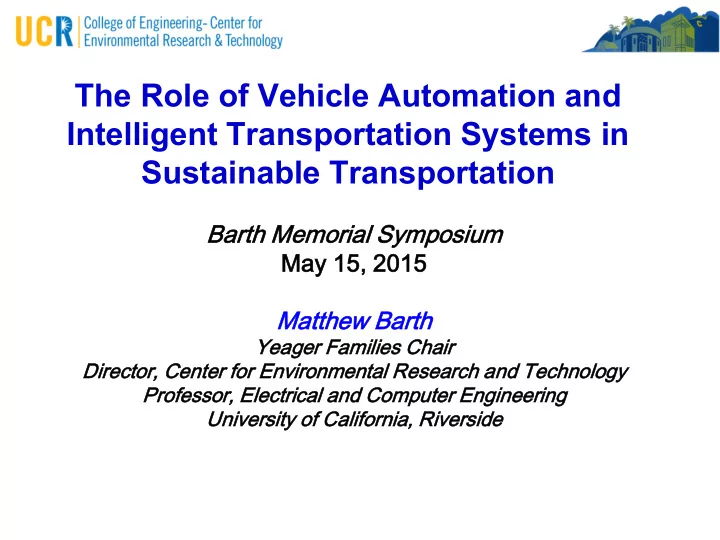

The Role of Vehicle Automation and Intelligent Transportation Systems in Sustainable Transportation Barth M h Memor orial Sympos posium um May ay 15, 15, 2015 2015 Matth tthew B Barth th Yeag eager Fam amilies Cha hair Direc ector or, Cent nter er for Environ onmen ental al Resear earch h and d Techn hnol ology ogy Prof ofes essor, Electrical al and d Comput puter er Engine neer ering ng Unive versi sity y of f Califor orni nia, a, River erside de
Charley’s Cars 1926 Ford 1936 Pontiac 1948 Ford convertible 1950 Pontiac 1958 VW Bug 1958 Austin Healey 1962 Ford Falcon 1964 Jeep Wagoneer 1968 Pontiac Catalina 1971 Chevy Blazer 1973 Opel Manta 1978 Pontiac Grand Am 1979 VW Sirocco 1983 BMW 318 1994 Chevy Truck 2000 Audi A6 2003 BMW X3
Too much of a good thing… Mobility: • personal mobility is an important part of a progressive society • U.S.: the automobile has become essential element of life • our mobility is often restricted due to limitations in transportation infrastructure • Resource Management Problem: • if resources (transportation infrastructure) are limited and demand is high, congestion occurs increased emissions
How do we minimize energy and emissions impacts from transportation? • Build cleaner, more efficient vehicles: • make vehicles lighter (and smaller) while maintaining safety • improve powertrain efficiency • develop alternative technologies (e.g., electric vehicles, hybrids, fuel-cell) • Develop and use alternative fuels: • Bio and synthetic fuels (cellulosic ethanol, biodiesel) • electricity • Decrease the total amount of driving: VMT reduction methods • Better land use/transportation planning • Travel demand management • Improve transportation system efficiency • Intelligent Transportation System (ITS) technologies • Connected Vehicles Vehicle Automation
Key ITS Research Areas with Energy/Emissions Impacts Advanced Vehicle Control and Safety Systems: Vehicles eliminating accidents • Longitudinal and Lateral Collision Avoidance smoother traffic flow • Intersection Collision Avoidance • Adaptive Cruise Control, Intelligent Speed Adaptation • Automated Vehicles and Roadway Systems Advanced Transportation Management Systems: Systems • Traffic Monitoring and Management eliminating congestion • Corridor Management efficient operation • Incident Management • Demand Management and Operations Advanced Transportation Information Systems: Behavior reduced driving • Route Guidance better efficiency • En-Route Driver Information travel demand mngt. • Traveler Service Information connection to Transit • Electronic Payment Services variable pricing indirect versus direct energy/emissions savings
Connected Vehicles: providing better interaction between vehicles and between vehicles and infrastructure • increased Safety • better Mobility • lower Environment impact
Eco-Approach and Departure at Signalized Intersections Roadside Equipment Unit Traffic Signal Controller with V2I Communications: SPaT Interface SPaT and GID Messages V2V Communications: Basic Safety Messages Vehicle Equipped with the Eco-Approach and Departure at Signalized Intersections Application (CACC capabilities optional) Traffic Signal Source: Noblis, November 2013 Head
Simulation Modeling… baseline eco approach & departure
Real-World Experimentation: Eco-Approach & Departure Example Run • Cycle length of 60 sec (26 green, 4 yellow, 30 red) • The vehicle approached the intersection when the light was red. The application guided the driver to slow down early and cruise pass the intersection when the light turned green, avoiding a full stop. Typi pical al f fuel uel sav aved ed: 15% 15% 20% 20% sav aving ngs w with aut autom omation… n… 9
Real-World Experimentation: Eco-Approach & Departure Example Run 10
Cooperative Adaptive Cruise Control applied to Intersections Baseline: typical queuing baseline CACC: ~17% less energy & emissions eco approach & departure
Different Intersection Management Systems traffic light stop signs Intersection reservation system with Source: David Kari, UCR, 2014 automated connected vehicles
Intelligent Transportation Systems Take Away Points: • ITS goals and strategies of improving safety and improving traffic performance (i.e. mobility) often reduce energy consumption and CO 2 emissions as a side benefit • Dedicated ITS strategies and systems can be designed to explicitly reduce energy consumption and CO 2 emissions: U.S. AERIS, Japan Energy ITS, EU EcoMove • Each ITS strategy can potentially reduce CO 2 emissions by approximately 5 – 15%; however with multiple strategies, greater savings can be achieved (ignoring induced demand)
Automation Take Away Points: • Partial and full automation can provide better energy & emission results compared to human-machine interfaces, depending on design of control system • With automation, system design trade-offs will exist between safety, mobility, and the environment (e.g., automated maneuvers) • Connected automated vehicles will likely have greater improvements in mobility and environment compared to autonomous vehicles • Potential induced demand effects: vehicle automation will likely increase travel demand so it may be necessary to also consider travel demand management techniques
Recommend
More recommend